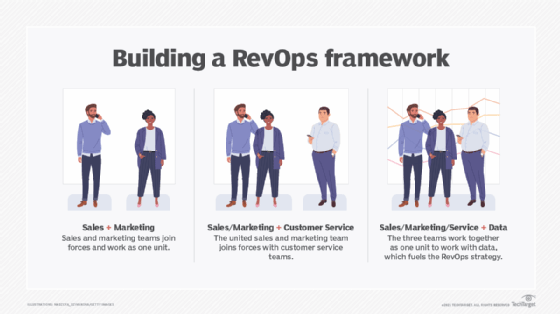
Getty Images
Getting started with a revenue operations strategy
A revenue operations strategy requires coordination and communication among sales, marketing and customer service teams to fuel RevOps.
Revenue operations -- or RevOps -- is a framework to align teams across an enterprise. With its focus on global optimization, end-to-end processes and a 360-degree customer view, this framework can benefit businesses of all kinds and introduce new operational strategies and efficiencies.
Organizations looking to understand and adopt this framework must develop a comprehensive plan for its implementation. Follow this roadmap to develop a RevOps strategy.
What is RevOps?
An organization that selects RevOps as its operational framework should prioritize process optimization, eliminate silos and commit to thorough coordination across the organization.
To ensure the organization prioritizes those processes, all teams involved must communicate. Organizations must create and implement an interdepartmental communications model to enhance mutual understanding and minimize ambiguity and misunderstanding. This serves the core framework, shown in the image below.
- Sales and marketing teams work in lockstep -- an engine and a transmission, respectively, that operate as one.
- The joint sales and marketing team coordinates to work with customer service teams.
- Sales, marketing and customer service groups work together with data that fuels RevOps strategies.

However, an organization can only achieve this coordination if it organizes its data architecture to serve this integration. The organization requires clean, accessible and near-real-time data assets, as well as clear and constant communication between all groups.
How to power a revenue operations strategy
Enhanced communication is the first step on the road to a RevOps strategy. But that journey requires a new and enhanced vehicle. Here are its moving parts.
Visibility: What's going on? RevOps requires descriptive analytics, which clearly defines the customer in demographic and behavioral views. Moreover, visibility means transparency of processes and clear performance metrics across the company, so teams can understand and properly score customer interactions and the processes that support them.
Insight: What should the organization do? Awareness drives insights into what will happen -- this is predictive analytics. The data can explain why product revenues are up or down, why marketing efforts fall short, customer behavior changes in key demographics and so on. Organizations can score these insights according to the likelihood of their accuracy, which can simplify strategic planning.
Action: How can the organization get it done? RevOps is a prescriptive discipline. That means the analytics used to understand customer interactions and what facilitates them can describe what's currently happening, predict what comes next and suggest the best course of action. This capability requires considerable resources, both human and technical, but the payoff can be worthwhile.
Perpetual change: What does the organization need to become? The commitment to RevOps is a commitment to perpetual change. It includes understanding that constantly fine-tuning processes means the organization can never settle in its ways and must follow and transform with the data -- changes in customer preferences, behaviors and life changes that drive them.
Fuel: How does the organization manage data? Even though communication is crucial to the RevOps engine, data -- mostly customer data -- fuels it and is mission-critical. An organization could have an abundance of customer information -- demographics, buying history, etc. -- available. However, the organization should also create and centralize a unified customer profile that includes online behaviors and an audit trail of every interaction with the organization so that employees can access this information.
The alignments of sales and marketing teams, and both with customer service teams, are essential. Yet, the alignment of the revenue engine to customer data is even more critical.
Building a RevOps team
As an organization develops a RevOps team, it must understand that the process reconfigures existing groups, so their interactions become more integrated.
Leadership. Someone in the C-suite should oversee RevOps overall. Often, this is the Chief Operating Officer or the newer role of Chief Revenue Officer, which is similar to a Chief Financial Officer but more strategic in practice.
Sales, marketing and customer service teams. The C-suite leader oversees the team, including members from sales, marketing, customer service and IT teams.
Analytics team. Business analysts make great team members as they understand processes and the underlying data. Therefore, the C-suite leader should form an analytics team -- ideally one with subject matter experts from each business area.
Data architecture expert. The team should also include at least one expert in the company's data architecture and at least one expert well-versed in IT-based analytics processes, such as machine learning and data modeling.
Team members should work together with transparency and mutual accountability to map out the overall strategy and then take their collective decisions and agenda back to their groups for implementation.
A fine-tuned RevOps team can boost strategic success through high-quality planning and execution. The team can also learn to spot red flags as soon as they surface, identify bottlenecks before they form and look ahead to see gaps in resources that aren't yet apparent.
Challenges in revenue operations strategies
Even if all goes well with each step of the RevOps implementation strategy, organizations are still likely to face challenges.
Data architecture. An analytics-friendly data ecosystem doesn't happen overnight. Organizations must consolidate transactional and historical data into new configurations -- usually aggregate data in data lakes -- that business intelligence tools and analytics software can easily consume. This requires investment in new data platforms the team can access and processes to clean data on its way into those platforms. The organization's data architecture team must thoroughly plan for these potential challenges.
Change management. Organizations shouldn't underestimate RevOps' perpetual change factor. The framework's goal is to constantly improve the organization and strive for greater efficiencies and optimization. This means any business process is subject to change, and any interaction with customers is a target for improvement. The organization must have the resources to develop processes and practices to facilitate smooth, orderly change management.





